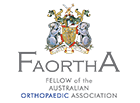Anterior Cruciate Ligament (ACL)
The Anterior Cruciate Ligament (ACL) is a large ligament (about the thickness of your little finger) inside the knee.
It is responsible for keeping the knee stable when performing cutting, twisting or turning movements. Occasionally, during sporting or high impact activities, the force through the knee is too much for the ligament to withstand and it snaps (other terminology used includes ACL tear, ACL rupture or ACL strain). At the time of the injury, it is common to sustain other injuries including meniscal tears, articular cartilage (joint surface) damage, bone-bruising, fractures, and other ligament damage.
Unfortunately, the ACL does not heal well and so the knee may remain unstable. This may be acceptable in daily activities, such as walking, but usually causes “giving way” of the knee during sport or when the knee is under stress. Each episode of giving way may lead to further damage in the knee, and may eventually lead to arthritis. It is therefore most often recommended that an ACL reconstruction (knee reconstruction) be performed. Prior to surgery, you should visit your physiotherapist (Nigel can recommend a sports knee physiotherapist to you) who will explain the rehabilitation program and ensure your knee is in good condition prior to surgery.
Preoperative and Postoperative information – ACL Reconstruction
Activities
It is important to keep your knee moving and the muscles around the knee working. The Quadriceps (thigh) muscles can lose up to 50% of their size within one week of an injury to the knee. Maintaining your core strength is important. Attending physiotherapy for a pre-surgery program of knee strengthening is important.
Activities that are good for your knee are:
- Cycling (stationary or road)
- Walking
- Weights work
- Squats or leg-press
- Gym work
- Treadmill
- Elliptical trainer
- Rowing machine
- Spin classes
- Pilates / Yoga
You can do these but there will be certain activities that you will not be able to do.
Activities that are not good for the knee are:
Weights work: No leg extensions or hamstring curls – these place unnatural forces across the knee joint.
Running: Not advised, but if you want to run do so in a straight line, on a flat surface.
Sport: Nigel will counsel against playing sport until 9 months after reconstruction and a return to sport test has been undertaken.
Before the operation
If surgery is required this will be undertaken either at:
- Northpark Private Hospital or
- St. Vincent’s Private Hospital Kew
Nigel will ask that you contact a physiotherapist to start pre-habilitation on your knee. On the day of surgery you will be seen by a number of staff members:
- Nurses
- Assistant
- Anaesthetist
- Hospital Physiotherapist
Nigel will see you and your leg will be:
- Clipped
- Washed with an anti-septic solution
- Will be marked so that the correct side is operated on
A needle will be put into one of your veins so that medication and fluid can be given during the surgery. You will then be given an anaesthetic that will make you fall asleep. Antibiotics will be given to prevent infection from occurring.
The operation
Anterior Cruciate Ligament Reconstruction is performed arthroscopically, with an additional cut made to obtain the graft material (either from the hamstring, patella, or quadriceps tendon). Tunnels are drilled into the femoral and tibial bone. The ACL graft is fixed into position with a titanium button and screw, which will not require removal. The operation usually takes about 45 minutes.
Two small cuts are made just underneath and either side of the patella (knee-cap). These cuts are made so that the arthroscope (the instrument that allows Nigel to look in your knee) and other instruments can be put into the knee to perform the operation.
One small cut on the inside part of the leg, which allows the tendons to be harvested to replace your torn ACL. Nigel will generally harvest two of your hamstrings tendons (semi-tendinosus and gracilis).
One puncture mark on the outside of your thigh.
Nigel will then perform an arthroscopy of your knee.
- Photographs and video of the inside of your knee will be taken (and will be given to you)
- Any other structures that have been damaged will be operated on before the ACL is reconstructed
A hole is drilled in the femur (thigh bone) and in the tibia (leg bone).The graft is then passed through the tunnels and is held in the femur (thigh bone) by a titanium button. The graft is then put through a range of movement before the graft in the tibia (leg bone) is held with a stainless steel screw. The knee is tested once more for stability before local anaesthetic is placed into the wounds and the wounds are sutured (sewn) with an absorbable suture (no stitches that need to be removed). Waterproof dressings are put over the wounds and the knee is bandaged.
Immediately after the operation
- You will be sore, even though pain medication has been given, and Nigel has put local anaesthetic around your knee.
- Your knee will be bandaged.
- You will have white stockings on and will have foot pumps to aid circulation.
- You will have a number of pain killing medications prescribed and if you can tolerate an anti-inflammatory medication will also be available.
- ICE will be placed onto your knee.
- You will be transferred back to the ward once your observations are stable.
On the ward
- You will be able to have food and drink once you feel up to it.
- ICING your knee will be encouraged.
- Pain-killer medications will be offered.
- You will be encouraged to get out of bed and start walking, with crutches, either with the physiotherapist or nursing staff.
- Nigel will come to see you towards the end of the day and will explain the results of the surgery.
Day 1 post-surgery
- Nigel will come and see you in the morning
- Your dressings may be changed
- You will have an x-ray prior to going home
- Most patients are able to go home the day after surgery
- The physiotherapist will see you
Discharge
When you are due to go home you will be given a prescription for aspirin, pain-killers and an anti-inflammatory if you can take them.
Your appointment to see Nigel will be given to you for 2 weeks after the operation (if not please contact Nigel’s secretary).
The physiotherapist will make sure you have follow-up arranged.
The nurses will reiterate the importance of :
- ICING your knee 30 minutes 4-5 times / day
- Keeping your leg elevated
- Keeping your foot moving (prevention of blood clots)
- Moving your knee as comfort allows
At home
- Continue with ICING your knee. Icing your knee is important to reduce the swelling. The quicker you reduce the swelling, the less painful the knee will feel, and the quicker you will get movement back in your knee
- Keep taking your pain-killing medications
- Use your crutches
- Exercise your knee as comfort allows
- If you have any doubts please read the post-operative rehabilitation protocol, contact Nigel’s rooms or your physiotherapist
- Keep moving your foot (to prevent blood clots)
Complications
As with any surgery, potential complications can occur, however the risk is low. Complications following ACL reconstruction include:
- Infection 1:200
- Deep vein thrombosis (blood clots)
- Swelling
- Bruising
- Nerve injury / Some degree of numbness 25%
- Knee stiffness 5%
- Pain
- Damage to other structures in the knee
- Graft rupture 8% (There is more chance of the non-injured ACL rupturing 15%)
- Osteoarthritis
- Great care is taken to prevent all known complications, however occasionally they do occur and need prompt attention. Please feel free to contact Nigel if you have any concerns regarding complications.
Infection
Infection of the wound or skin surrounding the skin (cellulitis) occurs in about 1-2% of people. When this occurs you will have to take antibiotics to settle the infection.
Infection in the knee joint occurs in 0.5% (1 in 200) – If this occurs, your knee joint will have to be washed out with a further operation and you will have to go on to antibiotics given through an Intra-venous (IV) drip.
If you develop any of the following signs:
- Redness
- Extra warmth
- Feeling unwell
- Pain in your groin
- Extra pain around your knee
- Sweats
- Fevers
- The wounds start to leak creamy fluid (pus)
Please seek urgent medical advice. These signs may indicate infection
Blood clots
- Deep Vein Thrombosis – DVT
- Pulmonary Embolus – PE
- The rate of DVT is around 20% (1 in 5)
- The best way of preventing DVT is to mobilise (get moving) after the surgery is performed
- The nursing staff will also give you exercises you can do in your bed or chair to help with blood flow in your leg
- You will also be given aspirin for 3 weeks, wear white stockings, and have foot pumps whilst in hospital
- Nigel and your anaesthetist will also discuss whether you may need to remain on blood thinning medication after you leave hospital.
This depends on:
- Medical conditions you may have, previous or family history of blood clots
- Medications you may be taking
- Your weight
- Whether you smoke
- Your level of mobility
Swelling
Your knee will be swollen after the operation and may take up to 8 weeks to settle. It is important to ICE your knee for 30 minutes / 4-5 times / day for the first 6 weeks. The greater the swelling the less you will be able to move your knee (particularly bending).
Bruising
You will get bruising around your knee but also up the inner part and back of your thigh. This occurs because the hamstrings tendons have been harvested from that area.
Numbness
Up to 70% of people will report a degree of numbness around their knee following surgery. This may settle down, but for a number of people remains. It is important to know that it is only a sensation change and does not affect any stability or mobility around the knee.
Wounds
People do heal differently particularly with respect to their scars. Some people will hardly see their scars whereas for others the scars will be prominent. The best guide to how your scars will heal is how other scars or wounds on your body have healed.
Movement
- Initially there is not much movement in your knee. The movement gets better as the swelling decreases.
- Bending of the knee at the 6 week mark is normally very good, however it is the getting the knee out straight that some people have problems with
- Your physiotherapist will work on this with you very closely. For a very small group of people fully straightening of the leg or knee does not occur and may be painful, and you may have to have another small operation to look inside the knee to see if any tissue is stopping the knee from getting out straight.
- In a small number of people the knee remains stiff, irrespective of how much work you and your physiotherapist have done. When this occurs it is called arthrofibrosis – this is where there is an excessive amount of scar tissue that has formed around the knee. One or two operations may need to be undertaken to help break down this extra scar tissue.
Graft failure
- The failure rate of ACL grafts is reported in the literature from 0-25% (the average being about 8%).
- The graft can fail for any number of reasons:
- Re-injury or trauma
- Return to sports activity or work to quickly
- Surgeon error
- Failure of fixation (the button and screw keeping the graft in place)
- Unrecognised other injuries to the knee at the time of surgery
- Failure of the graft to heal
- Nigel will explain ways that you can lessen your chances of this occurring and will also explain what he can do to also minimise the graft from failing
Osteoarthritis
Is wear and tear arthritis. The articular cartilage, the cartilage that lines the bones wears away. It is generally accepted that irrespective of whether you have an ACL reconstruction or not, you will develop arthritis in your knee. It is difficult to determine when you will get arthritis, and will depend on whether there was damage to the articular cartilage at the time of the original injury, seen at the time of surgery, and how you treat your knee after the surgery.
ACL Reconstruction Exercise and Rehabilitation Protocol
The rehabilitation protocol
With you undergoing surgery to reconstruct your ACL you will be given a rehabilitation protocol that will state what you should be doing and over what time period.
You should give a copy to your physiotherapist to follow and if they have any questions please ask them to contact Nigel’s rooms.
Time periods
Phase 1 (0-2 weeks)
Recovery from surgery
Phase 2 (2-6 weeks)
Range of movement
Low Impact
Phase 3 (6-12 weeks)
Range of movement
Basic strengthening
Neuromuscular control
Phase 4 (12-24 weeks)
Phase 5 (>24 weeks)
Running Agility Jumping Landing
Return to Sport 9 months (12 months if under the age of 18)
Phase 1: Recovery from Surgery - (0-2 weeks approximately)
Key Components of Rehabilitation
- Rest for 2 weeks post surgery
- Settle joint with ice and compression (30 minutes / 4-5 times / day)
- Range of motion exercises
- Introductory muscle strength exercises
Mobilise: Weight-bearing as tolerated with crutches
Exercises:
- Extended knee
- Bend knee
- Set quads
Phase 2: Range of Motion & Low Impact - (2-6 weeks approximately)
- Key Components of Rehabilitation
- Contact a sports knee physiotherapist
- Come off crutches
- Remove splint/ROM brace
- Settle joint with electrotherapy, ice and massage
- Restoration of range, particularly extension Exercises: 1) Balance training 2) Low resistance cycling 3) Swim with pool buoy 4) Balance training
Phase 3: Basic Strength & Neuromuscular Control - (6-12 weeks approximately)
Key Components of Rehabilitation
Gym based exercise program:
- Squats
- Leg presses
- Step-ups
- Cycling
- Swimming (NO breast-stroke)
- Walking
- Stair master
- Elliptical trainer
- Treadmill
- Rowing machine
NO leg extensions or hamstring curls
Phase 4: Running, Agility, Jump & Land - (12-24 weeks approximately)
- Key Components of Rehabilitation
- Advanced strength / neuromuscular program for lower limb strength
- Core strength
- Straight-line jogging/running progression
- Structured, conscious agility progression
- Jump and land and hopping progression
- Sport specific activities
- Pre-season training
- Light court work
- NO contact drills/NO game time
Phase 5: Return to Sport - (20 weeks +)
- Key Components of Rehabilitation
- Continuation of advanced strength and neuromuscular program
- Sport specific exercises and conditioning sessions
- Progression of change of direction and cutting, conscious to unconscious
- Restricted to unrestricted training
- Progressive game play
Return to Sport Test
Once your knee has rehabilitated to a level where you are considering a return to sport, a test will be performed to determine if you can return to your sports activities.
The test is composed of three parts:
- You filling out a questionnaire
- The physiotherapist examining your knee
- You performing a series of activities that the physiotherapist will then score you on
The test is scored out of 100, and the expectation is that you will score 100.
Different sports have different scores attached to them and the physiotherapist will discuss the relevance of the scores with you.
If you do not score well this is an indication that your knee is not yet strong enough to cope with the demands of your sports activities and it will be recommended that you not return to sport at that time. You can sit the test as many times as you wish.
Important Note:
Times for each phase are approximate only and based on the progress of each individual patient. The patient should complete goals in each phase before commencing with the main components of the next phase. Everyone will progress at different rates and some people will be faster in some phases but possibly slower in others. The key aspect of rehabilitation is that it is not a race because your return to sport will be guided by Nigel and your physiotherapist.
In phase 5 the following link would be beneficial to view: f-marc website
Please feel free to contact Nigel with any queries regarding this protocol or the progress of our patient.



